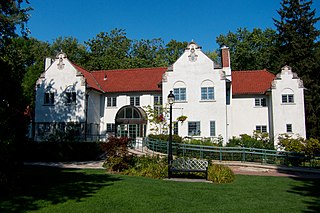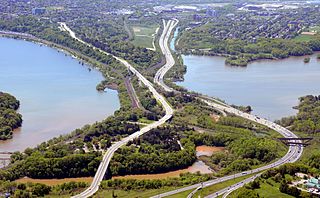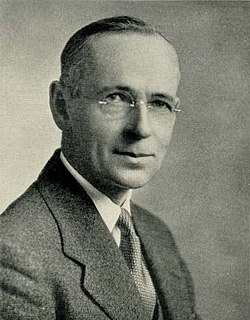
The Bruce Trail is a hiking trail in southern Ontario, Canada, from the Niagara River to the tip of Tobermory, Ontario. The main trail is more than 890 km (550 mi) long and there are over 400 km (250 mi) of associated side trails. The trail mostly follows the edge of the Niagara Escarpment, one of the thirteen UNESCO World Biosphere Reserves in Canada. The land the trail traverses is owned by the Government of Ontario, local municipalities, local conservation authorities, private landowners, and the Bruce Trail Conservancy (BTC). The Bruce Trail is the oldest and longest marked hiking trail in Canada. Its name is linked to the Bruce Peninsula and Bruce County, through which the trail runs. The trail is named after the county, which was named after James Bruce, 8th Earl of Elgin who was Governor General of the Province of Canada from 1847 to 1854.

St. Catharines is the largest city in Canada's Niagara Region and the sixth largest urban area in the province of Ontario, with 96.13 square kilometres of land and 133,113 residents in 2016. It lies in Southern Ontario, 51 kilometres (32 mi) south of Toronto across Lake Ontario, and is 19 kilometres (12 mi) inland from the international boundary with the United States along the Niagara River. It is the northern entrance of the Welland Canal. Residents of St. Catharines are known as St. Cathariners. St. Catharines carries the official nickname "The Garden City" due to its 1,000 acres (4 km2) of parks, gardens, and trails.

Niagara-on-the-Lake is a town in Ontario, Canada. It is located on the Niagara Peninsula at the point where the Niagara River meets Lake Ontario, across the river from New York, United States. Niagara-on-the-Lake is in the Niagara Region of Ontario, and is the only town in Canada that has a Lord Mayor. It has a population of 17,511 (2016).

The Regional Municipality of Niagara, also colloquially known as the Niagara Region, is a regional municipality comprising twelve municipalities of Southern Ontario, Canada. The regional seat is in Thorold. It is the southern end of the Golden Horseshoe, the largest megalopolis in Canada.

Queenston is a compact rural community and unincorporated place 5 kilometres (3.1 mi) north of Niagara Falls in the Town of Niagara-on-the-Lake, Ontario, Canada. It is bordered by Highway 405 to the south and the Niagara River to the east; its location at the eponymous Queenston Heights on the Niagara Escarpment led to the establishment of the Queenston Quarry in the area. Across the river and the Canada–US border is the village of Lewiston, New York. The Lewiston-Queenston Bridge links the two communities. This village is at the point where the Niagara River began eroding the Niagara Escarpment. During the ensuing 12,000 years the Falls cut an 11 kilometres (6.8 mi) long gorge in the Escarpment southward to its present-day position.

Thomas Baker McQuesten was a politician in Ontario, Canada. He was a Liberal member of the Legislative Assembly of Ontario from 1934 to 1943 who represented the riding of Hamilton—Wentworth. He served as a cabinet minister in the governments of Mitchell Hepburn and Gordon Conant.

The Adamson Estate, which forms the eastern boundary of the Port Credit neighbourhood of Mississauga, Ontario, was purchased from the family of Agar Adamson by Credit Valley Conservation Authority in 1975 upon the urging of the local ratepayers group known as Project H21 after a proposed real estate development which would have changed the character of the neighbourhood. It is now a public park on the Waterfront Trail. It was recognized as a Historic Place in 1978.

The downtown core of St. Catharines, Ontario, Canada is defined by the city as the area between Highway 406 on the west and south, Geneva Street on the east until it reaches St. Paul Street then Niagara Street north until it meets Welland Avenue.

Painshill, near Cobham, Surrey, England, is one of the finest remaining examples of an 18th-century English landscape park. It was designed and created between 1738 and 1773 by Charles Hamilton. The original house built in the park by Hamilton has since been demolished.

Hatley Park National Historic Site is located in Colwood, British Columbia, in Greater Victoria. It is the site of Hatley Castle, a Classified Federal Heritage Building. Since 1995, the mansion and estate have been used for the public Royal Roads University. From the 1940s to 1995, it was used for the Royal Roads Military College, a naval training facility.

Whitehern Historic House and Garden in Hamilton, Ontario, Canada, built shortly before 1850, is a Late Classical house that is now a historic house museum.

Willowbank is an independent educational institution located on the Willowbank National Historic Site and in the village centre of Queenston, Ontario, along the Canada-United States border. It operates a School of Restoration Arts which offers a three-year post-secondary diploma in conservation skills and theory, and a Centre for Cultural Landscape, a forum for cultural landscape theory and practice in Canada and the world. Willowbank was created from the rescue of a 19th-century estate which today forms the centre of its campus, and it is one of a handful of Canadian organisations of which His Royal Highness The Prince of Wales is Royal Patron.

Burlington Heights refers to a promontory or area of flat land sitting elevated above the west end of Hamilton Harbour in the city of Hamilton, Ontario which continues as a peninsula to the north toward the city of Burlington, Ontario. It separates Cootes Paradise Marsh on the west from the harbor on the east. Geologically the Burlington Heights is a sand and gravel bar formed across the eastern end of the Dundas Valley by Glacial Lake Iroquois. It is the northern continuation of the longer Iroquois Bar which extends south into Hamilton.
This is a list of Training programs for Conservation and Restoration of cultural heritage.

The Toronto Power Generating Station is a former generating station located along the Niagara River in Niagara Falls, Ontario, Canada, slightly upstream from the newer Rankine power station. Completed in 1906 in the Beaux-Arts-style, the station was designed by architect E. J. Lennox and was built by the Electrical Development Company of Ontario under supervision of Hugh L. Cooper to supply hydro-electric power to nearby Toronto, Ontario.

The Cheltenham Badlands are located northwest of Toronto, Ontario, on the south east side of Olde Base Line Road, between Creditview and Chinguacousy Roads. The site occupies an area of approximately 0.4 square kilometers and features exposed and highly eroded Queenston Shale. The Cheltenham Badlands are a significant educational site due to the readily visible geologic processes and the red color and the unique topography of the exposed shale makes this a popular tourist site. The site is a Provincial Earth Sciences Area of Natural and Scientific Interest (ANSI) since it is considered as one of the best examples of "badlands topography" in Ontario.

The Hamilton Waterworks, also known as the Hamilton Waterworks Pumping Station, is a National Historic Site of Canada located in Hamilton, Ontario. It is an industrial water works structure built in the Victorian style, and a rare example of such a structure in Canada to be "architecturally and functionally largely intact". It is currently used to house the Museum of Steam and Technology.

William Lyon Somerville was a Canadian architect practicing in Toronto, Ontario and Southern Ontario, Canada. He was President of the Ontario Association of Architects, and president of the Royal Architectural Institute of Canada. He was an accomplished architect who designed hospitals, commercial and institutional buildings, residential buildings. Somerville designed the original McMaster University buildings in Hamilton, Ontario and the Rainbow Tower complex in Niagara Falls. He also designed several monuments, including the Clifton Gate Pioneer Memorial Arch in Niagara Falls and the Henley Bridge and Queen Elizabeth Way Monument for the new Queen Elizabeth Way superhighway built in the late 1930s and early 1940s.


















